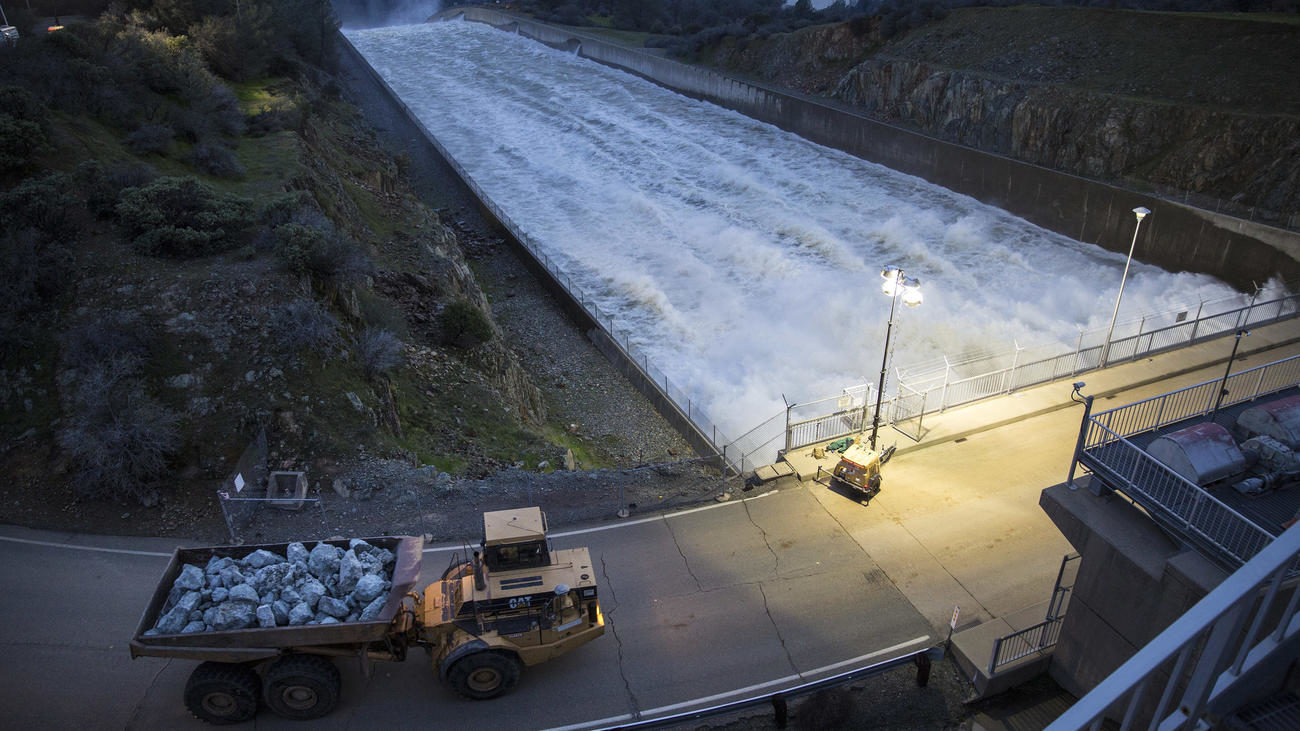
Oroville Dam Spillway
The
water level at Lake Oroville continues to drop as state officials press on with the effort to drain the reservoir in light of a forecast calling for rain through Monday. Despite forecasts showing another "atmospheric river" poised to strike the region early next week,
engineers began dialing back the water releases from Oroville Dam's main spillway Thursday in an effort to eventually restart the dam's shuttered hydroelectric plant. When operational, the plant could release additional water from Lake Oroville.
After pounding the damaged spillway with releases of 100,000 cubic feet per second since Sunday evening, the state Department of Water Resources dialed back the releases to 94,000 by late Thursday morning. DWR's website indicated releases would fall to 80,000 cfs by 3 p.m.
Even with the curtailed releases, the water level at troubled Lake Oroville continued to decline.
The reservoir was falling by about 5 feet every 12 hours and was down to 867.5 feet just before noon, or nearly 34 feet below the top of the dam. Federal flood regulations say the lake should be at no more than 850 feet this time of year.
Officials had said they would start throttling back the releases to resume pulling debris from the river channel beneath the dam. The debris has backed up the river at a critical point, preventing the state from restarting the dam's hydroelectric power plant. The plant would be capable of releasing up to 13,000 cfs.
Independent experts told
The Sacramento Bee the strategy makes sense. The reservoir should be empty enough to handle the inflow from the "atmospheric river" forecast for Monday, and getting the power plant working again will prove vital to navigating the rest of winter and into spring, when snowmelt from the Sierra will create heavy inflows.
"They think they've got the reservoir under control," said water policy expert Jeffrey Mount of the Public Policy Institute of California. "They've got the breathing room."
Joe Countryman, a former U.S. Army Corps of Engineers official, added: "They're thinking down the road. It's very, very important to make that (power plant) functional, no doubt."
Countryman said the releases down the main spillway still will be considerable. "It's not like they're cutting it back to zero; 80,000 (cfs) is a lot of water."
Meanwhile, the National Weather Service predicts an "atmospheric river" will strike the area beginning Monday, putting renewed strain on the reservoir.
The lake level fell by nearly 5 feet in the 12-hour period ending at 10 a.m., dropping to below 868 feet. That was about 33 feet below the top of Oroville Dam even as the first in a series of storms hit the Oroville region late Wednesday.
The first storm didn't bring significant rains, but the National Weather Service reported that a warm, heavy storm known as an atmospheric river is expected to roll into the Feather River basin Monday and Tuesday.
"It is looking like the system for next week is trending wetter and warmer," said Michelle Mead of the National Weather Service in Sacramento.
However, Mead said the rainfall is expected to be only half as heavy as last week's storm, which swamped Lake Oroville with peak inflows of 191,000 cubic feet per second just as Oroville Dam's main spillway suffered a massive crater.
The giant fracture in the main concrete spillway Feb. 7 temporarily hobbled dam operators' ability to push water out of the reservoir, causing the reservoir to fill and water to flow over the never-before-used emergency spillway. Some 180,000 downstream residents were ordered to evacuate Sunday when state officials feared the emergency spillway was in danger of failing. The crisis eased and evacuations ended Tuesday.
Despite damage to the main spillway, dam officials have been releasing water at 100,000 cfs nonstop since late Sunday to increase flood-control space. DWR officials say they don't believe the erosion in the spillway has worsened.
"We want to keep taking water out of that reservoir for flood-control space," said Chris Orrock, state Department of Water Resources spokesman.
Meanwhile, crews working to reinforce the emergency spillway were able to continue their efforts through the night despite periods of heavy wind and rain.
Windy conditions and more rain are forecast for Thursday. Helicopters that have been dropping bags of rocks on emergency spillway this week likely will be grounded Thursday.
And, if the hillside becomes too slick, ground crews using dump trucks to pour boulders onto the spillway will have to stop their work. The boulders are designed to fortify the eroded hillside at the foot of the emergency spillway's 1,700-foot concrete apron.
"We want to make it through this weather system and re-evaluate where we are at," Orrock said.
The National Weather Service is forecasting a half to an inch of rain to fall Thursday in Oroville. Perhaps another half inch could arrive on Friday.
However, the early storms are relatively cold and snowy, alleviating pressure on the reservoir. That's expected to change. Mead said the 7-day forecast for Oroville calls for a total of 10 inches or so of rain, with much of it coming Monday and Tuesday. Snow levels in the Sierra could be as high as 7,000 feet, she said.
While not as bad as last week, when snow levels were higher and total rainfall approached 20 inches in the Feather River basin, Mead said the reservoir can expect a significant amount of new water.
"Enhanced inflows are expected," she said.
Reader Comments